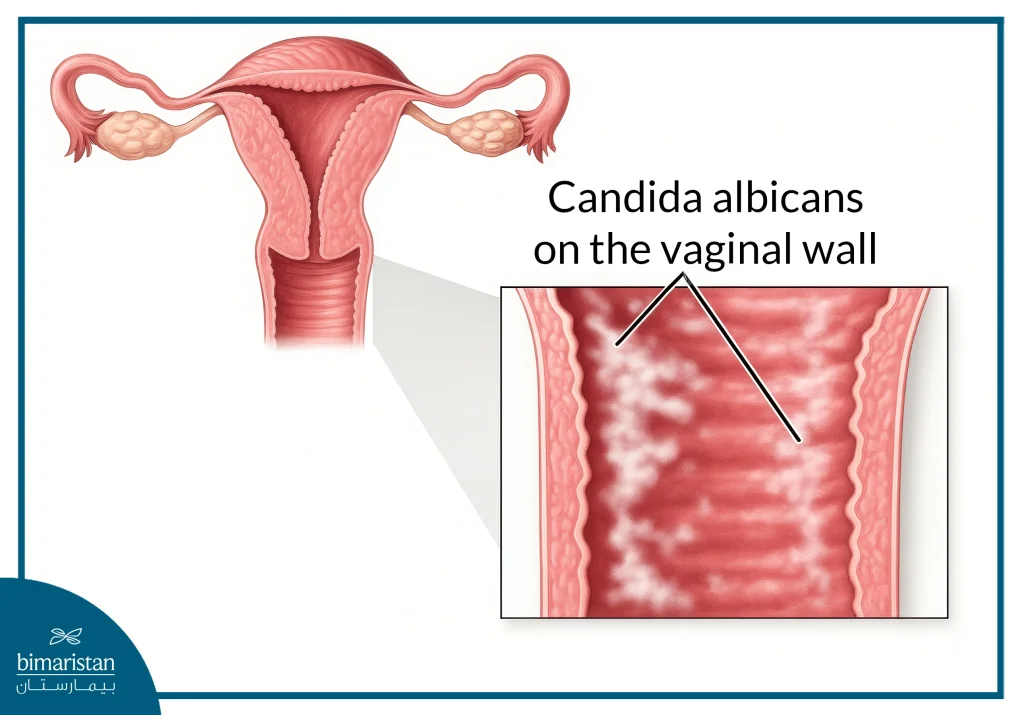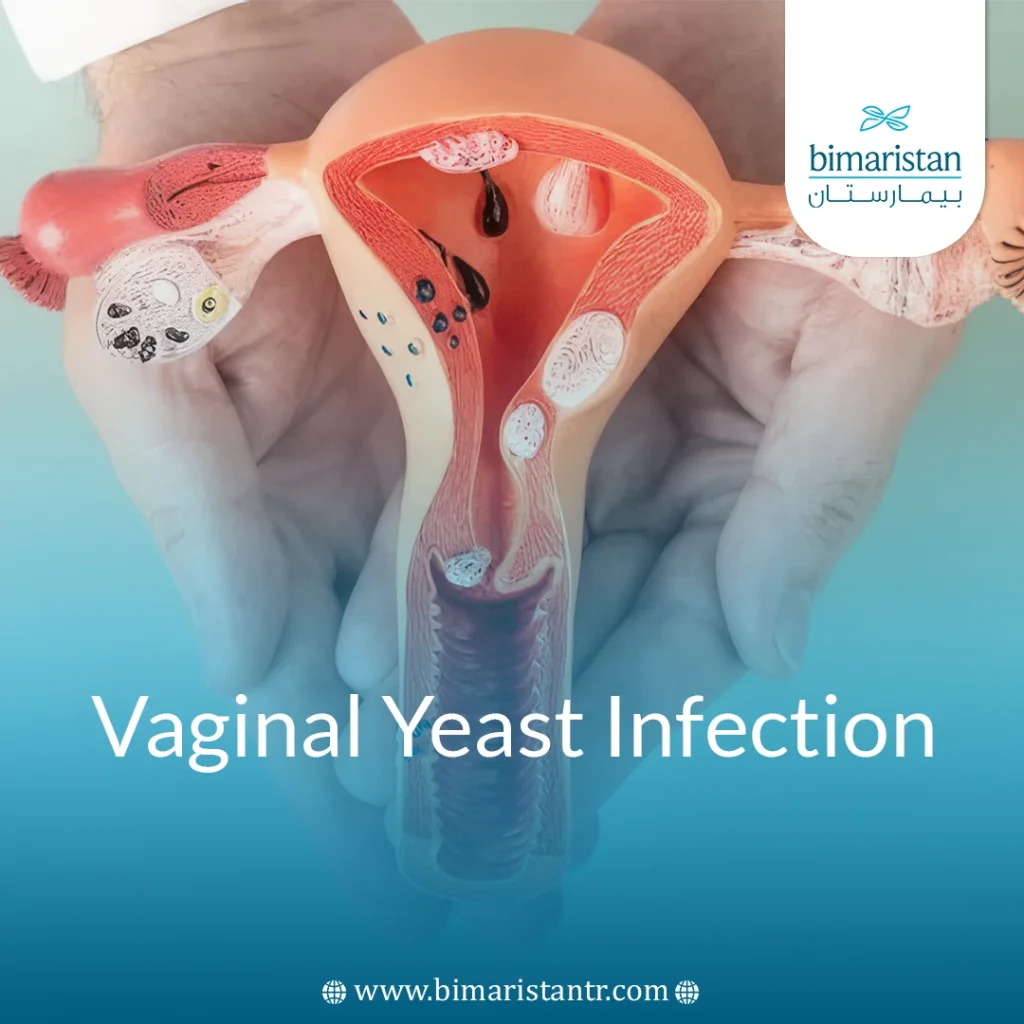Bacterial vaginosis is one of the most common gynecological infections, and most women get it at least once in their lifetime. Although it is not considered a sexually transmitted disease, certain factors may increase the risk of contracting it. Early detection and correct diagnosis can help relieve symptoms quickly, minimize complications, and prevent future re-infection, especially since it may sometimes be confused with a vaginal yeast infection.
What is a vaginal yeast infection?
Vaginal yeast infection, also known as vaginal candidiasis, is a fungal infection caused by the overgrowth of a fungus called Candida albicans, which normally lives in the vagina without causing issues. The infection occurs when the balance between beneficial bacteria and fungi within the vagina is disrupted, allowing the fungus to overgrow.
Vaginal yeast infection is categorized as a form of vaginitis that differs from other types of vaginitis in terms of cause and treatment. It is estimated that about 75% of women will experience this type of vaginitis at least once, and a large percentage of them will suffer from more than one infection during their lifetime. Its forms vary between acute (sudden onset), recurrent (four or more infections per year), and treatment-resistant (when symptoms persist for a long time or are difficult to treat).
What are the causes of vaginal yeast infection?
The causes of vaginal yeast infection are numerous and can be categorized into factors related to the fungus itself and factors that increase susceptibility.
Causative fungi
The main cause of vaginal yeast infection is the overgrowth of a fungus called Candida albicans, which occurs naturally in the vagina, mouth, digestive tract, and skin without causing symptoms. This fungus is normally balanced by other beneficial bacteria such as Lactobacillus, which prevents fungal overgrowth and keeps the vagina healthy. When this balance is disrupted, Candida grows too quickly and attaches itself to the surface of vaginal cells, causing the recognizable symptoms of infection. Sometimes other types of Candida can be responsible for the infection, and these can be more resistant to treatment.

Risk factors
Several factors disrupt the normal balance of fungi and bacteria in the vagina, increasing the risk of developing conditions such as BV or a vaginal yeast infection, the most important of which are:
- Use of antibiotics: Antibiotics kill the beneficial bacteria that keep the vagina in balance, allowing the fungus to overgrow.
- Pregnancy: High estrogen during pregnancy contributes to increased fungal growth.
- Uncontrolled diabetes: High blood and urine sugar provide a favorable environment for fungal growth and affect the immune system.
- Weakened immunity: The body’s ability to control the fungus is reduced, which can be caused by diseases such as HIV or by the use of immunosuppressive medications such as cortisone.
- Use hormonal contraceptives or hormone therapy: Increases estrogen levels that promote fungal growth.
- Exposure to constant moisture: Such as wearing tight clothing or staying for long periods of time in wet clothes.
- Using irritating products: such as vaginal washes or perfumes that alter the natural balance in the vagina.
- Psychological stress: May affect the body’s response and increase the likelihood of infection.
Symptoms of vaginal yeast infection
Symptoms of vaginal yeast infection range from mild to moderate, and include:
- Severe itching and irritation in the vagina and surrounding area (vulva)
- Vulvar redness, which is less noticeable in darker-skinned women
- Thick, white-colored vaginal discharge, usually without a strong odor
- Burning sensation during urination and pain during intercourse
- General vaginal pain or discomfort
- In some cases, small cracks or fissures may appear in the skin of the vulva
Diagnosing vaginal yeast infection
Diagnosis of vaginal yeast infection is based on a description of symptoms and a clinical examination of the genital area. The doctor usually starts with a pelvic exam to look for signs of redness, swelling, or abnormal discharge in the vagina and cervix. A sample of vaginal discharge is taken with a cotton swab and then examined under a microscope to check for Candida overgrowth.
In some cases, a wet mount or KOH test is performed to help confirm the diagnosis, a laboratory culture of the fungus may be ordered if the infection is recurrent or does not respond to treatment, and additional tests may be used to rule out other causes whose symptoms mimic those of vaginal yeast infection.
Vaginal yeast infection treatment
Treatment options vary depending on the severity of symptoms and frequency of infection, and are usually divided into two main types:
Antifungal medications
In mild to moderate cases, treatment typically involves the use of antifungal vaginal suppositories or creams, such as miconazole or clotrimazole, for 3 to 7 days. Additionally, oral pills like fluconazole may be prescribed, often taken as a single dose and repeated as needed in more severe cases.
These treatments are available by prescription or over-the-counter, and treatment should be completed even if symptoms subside to avoid re-infection.
Treating recurrent fungal infections
If the infection recurs four or more times in a year, a long-term treatment plan will be necessary, including:
- Prolonged vaginal treatment: Using daily antifungals for up to 14 days, followed by weekly prophylaxis for 6 months.
- Frequent oral pills: Like fluconazole, these are given at specific intervals as assessed by your doctor.
- Boric acid suppositories: They are used in some treatment-resistant cases, but must be used under close medical supervision and should not be taken orally or used during pregnancy.
- – Treating secondary causes such as diabetes or immune dysfunction.
Tips for preventing vaginal yeast infections
Vaginal yeast infection can be prevented by adopting some healthy daily habits, such as:
- Avoid vaginal douches and scented products such as sprays, pads or tampons
- Wear cotton underwear and avoid tight-fitting underwear to minimize irritation and moisture
- Changing wet clothes quickly, such as swimsuits or workout clothes
- Keep your vagina and vulva clean and dry, and change sanitary pads regularly
- Use water-based lubricants during intercourse to avoid friction and irritation
- Controlling blood sugar in diabetic patients to minimize the risk of infection
- Avoid overuse of over-the-counter antibiotics
When should I see a doctor?
See a doctor if this is the first time you are experiencing symptoms of a vaginal yeast infection, or if you’re unsure of the cause. It’s also important to seek medical advice if symptoms persist after using over-the-counter treatments, worsen over time, or if new symptoms develop. If there’s a chance of a sexually transmitted infection, medical evaluation is necessary.
In conclusion, a vaginal yeast infection is a common condition that can be effectively managed with proper treatment if diagnosed early. Medical follow-up and adherence to preventive measures are key to minimizing recurrence. Don’t hesitate to consult a healthcare provider if you experience any symptoms or suspect an infection—it’s essential for maintaining vaginal health and overall well-being.
Sources:
- Office on Women’s Health. (2025, February 27). Vaginal yeast infections. U.S. Department of Health & Human Services.
- National Library of Medicine. (2023, October 20). Vaginal yeast infection. MedlinePlus.
